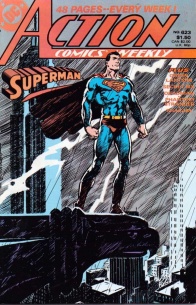In today’s Chronicles of Shazam, we focus on a four-part story serialized in 1988’s “Action Comics Weekly,” which would mark the last solo Captain Marvel story for nearly six years, and the last major appearance until 1991.
Written by Roy and Dann ThomasCover by Brent Anderson
Penciled by Rick Stasi
Inked by Rick Magyar
Colored by Nansi Hoolihan
Lettered by Jean Simek
After departing “Justice League International,” Roy and Dann Thomas, writers of “Shazam: The New Beginning,” wrote a four part story for “Action Comics Weekly.” A brief tangent: I so, so wish that DC would do a title like this again. It was anchored by Green Lantern stories, but also featured short runs of characters like Black Canary, Secret Six, and Deadman, all featured within these four issues. It was a really fun experiment and one, frankly, I may cover for next summer’s Comics Binge.
Anyway, so this four part story was, seemingly, intended to be yet another launching point for a Shazam ongoing series, one that never materialized. According to an amazing article in the July 2001 issue of his Alter Ego fanzine, Roy Thomas had huge plans for an ongoing book that would’ve featured a new Marvel family that never materialized. So, this is the end of Thomases’ run with the character and, unfortunately, a lot of it feels like a re-tread.
The story is kicked off by Captain Marvel, just like in “Legends,” accidentally killing someone in the line of battle. Whereas in “Legends” it turned out he didn’t actually kill anyone, here it appears that Marvel was set up to kill the henchman. I suppose it doesn’t quite excuse the action as much as the “Legends” story did, but it still firmly places the blame off of Cap.
This story also brings Captain Nazi, a classic Fawcett-era Cap villain, into the post-“Crisis” era, and does so in a way that doesn’t seem as hokey as you’d expect a character named “Captain Nazi” would be. In fact, the Thomases do a really nice job giving the Neo-Nazis some real agency and motivation, without giving them a drop of sympathy. It is very clear in these pages who, if any, of the people involved with the ‘Sons of Valhalla’ are worth our care (spoiler alert: there’s one, who is reluctant to be an evil asshole).
Rick Stasi brings a bit of a different touch to the characters here, seemingly aging Batson a couple of years, giving him a far more teenaged look than we saw from John Byrne in “Legends” or Tom Mandrake in “The New Beginning.” His Captain Marvel is a little bulkier and tougher looking, too, whereas his Captain Nazi retains a lot more of the classic Fawcett look, especially in terms of his facial features. The eyes are where Stasi returns to the past, with a few panels of Billy looking almost Little Orphan Annie-ish with his doe-eyes.
Stasi also draws Cap with a longer cape than we’d seen in prior issues (though not as long as we’d get in the New 52), another way of making the character updated from the Fawcett days. His Marvel doesn’t look out of place, and he still retains a lot of the look from the past, but there’s something a little grizzlier about him. That’s not a criticism, but rather just an evolution of the character.
Of course, there are a fair number of elements that date this issues, but that’s to be expected: Don Henley references, Henry Kissinger being identified as a target of right-wing nutjobs (?), and a character calling his sister a “Buttinsky.” But overall, this story works really well in any time frame. Part of that is the way the Nazis are given such little sympathy, and part of that is how Captain Nazi is presented so timelessly.
The only real glaring flaw in the story is how the final act of it seems rushed; if there were a fifth installment, the story would’ve been paced much more effectively, and wouldn’t have felt so rushed. But you can tell that the Thomases believed they’d be able to follow through with some of these elements in future stories, so it likely didn’t feel quite as finite and rushed to the finish if a few months later, there was an ongoing to pick up some of these pieces.
Overall, this is another successful Shazam story from this era. The lack of an ongoing is pretty glaring when you see just how well DC had set the character up for success. Again, that Alter Ego article really goes into detail, but it’s amazing just how forgotten Captain Marvel became after this story. It would be almost three years before another major Captain Marvel appearance, which was in the “War of the Gods” crossover/miniseries in 1991. We’ll tackle that next week.
See ya in 7.







